What began as a disappointing Euro 2024 Qualifying campaign for the Georgian national team culminated in the crowning achievement of their recent resurgence in international football- a ticket to their first-ever major tournament in Germany.
After a nerve-wracking penalty shootout victory against former European champions Greece, it was evident that their success transcended football and represented significant national pride, with celebrations spilling onto the pitch in Tbilisi.
While upcoming superstars such as Khvicha Kvaratskhelia have certainly grabbed the headlines, Willy Sagnol’s Georgian team has been propelled by the collective spirit of a talented young core.
Their qualification may come as a surprise to many, considering the country’s sporting reputation and previous performance, but the Georgian FA has finally reaped the rewards of a meticulous effort to promote the development of upcoming Georgian talent.
Looking ahead to the Euros, Georgia will undoubtedly have a challenge on its hands, having been drawn in Group F alongside Portugal, Turkey, and the Czech Republic.
However, there is a quiet optimism that Georgia can surprise the masses and snatch a few results, with head coach Sagnol claiming that his team are not travelling to Germany just to be ‘tourists’.
This tactical analysis will begin to highlight just how the French manager’s tactics have transformed Georgia with and without possession, with a scout report shining light upon their brightest assets.
Predicted Starting XI
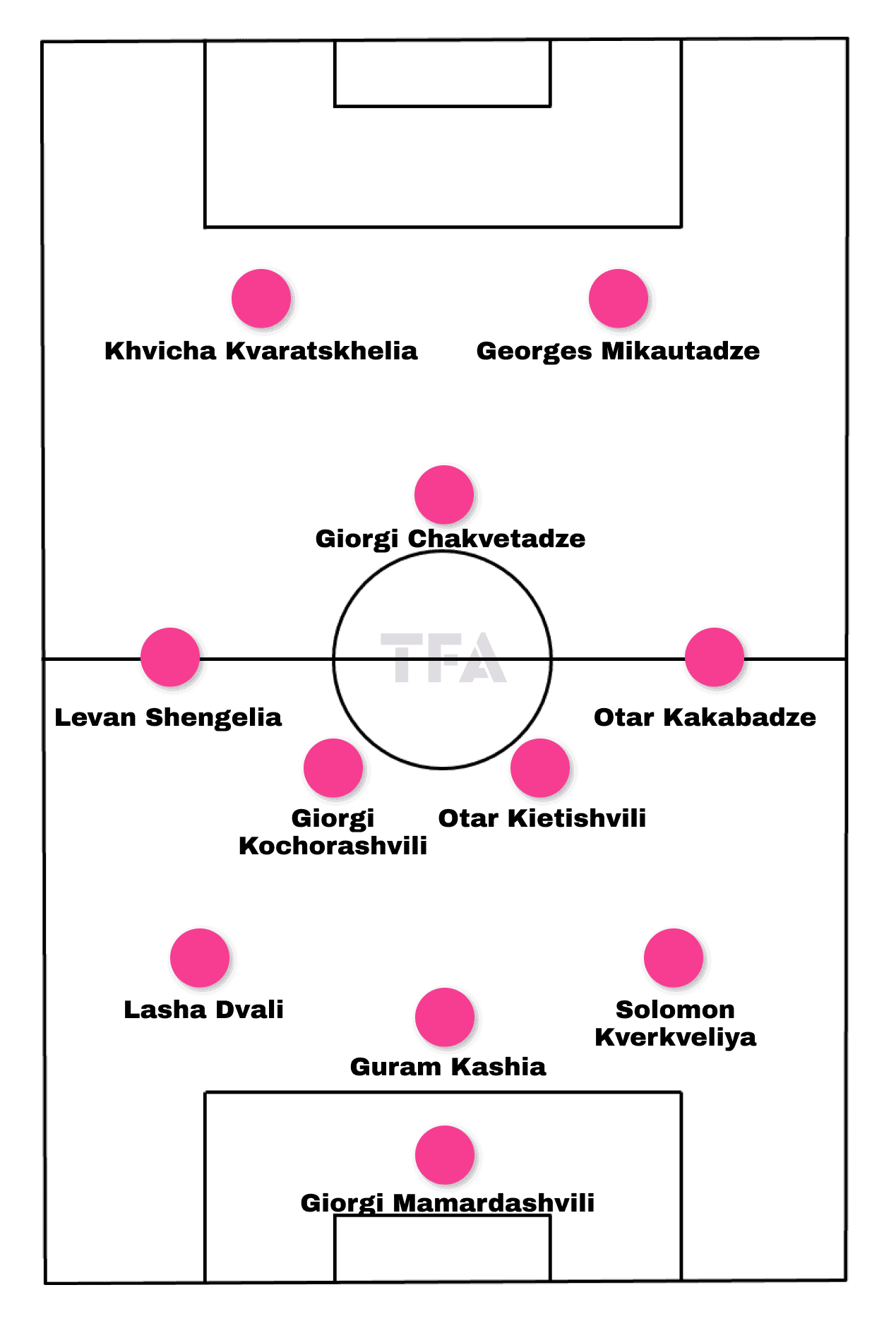
After qualification struggles when setting up variations of the 4-4-1-1 and 4-4-2, we can expect Willy Sagnol to stick with the 3-5-2, which saw them emerge victorious in both Euro Playoff matches against Luxembourg and Greece.
Giorgi Mamardashvili is Georgia’s guardian between the sticks, coming straight off the back of a formidable individual season with Valencia, preventing 8.7 goals on the pathway to 13 league clean sheets.
Georgia’s three-man central defence should be comprised of Lasha Dvali, Guram Kashia and Solomon Kvirkvelia, with the trio remaining resolute with successive games without conceding at the Playoff stage.
The wing-backs Levan Shengelia and Otar Kakabadze are imperative to Georgia’s overall play and work extremely hard to keep this side ticking on both sides of the ball.
The interior midfield will see both Giorgi Kochorashvili and Otar Kiteishvili negating space for the opposition to operate, especially against stronger sides looking to take advantage of increased possession.
The dynamic forward trio are certainly Georgia’s brightest spark, which will be integral to any instance in which Sagnol’s side can upset some of Europe’s regular heavyweights.
Watford’s Giorgi Chakvetadze represents an essential bridge between midfield and attack, a willing ball-carrier with the expert distribution to switch the ball with ease.
Georges Mikautadze partners Napoli phenom Khvicha Kvaratskhelia along the front line, with head coach Sagnol very open in claiming Georgia’s star man must be more central in possession, ready to avenge a season in which his attacking output waned in comparison to his excellent breakout year in Italy.
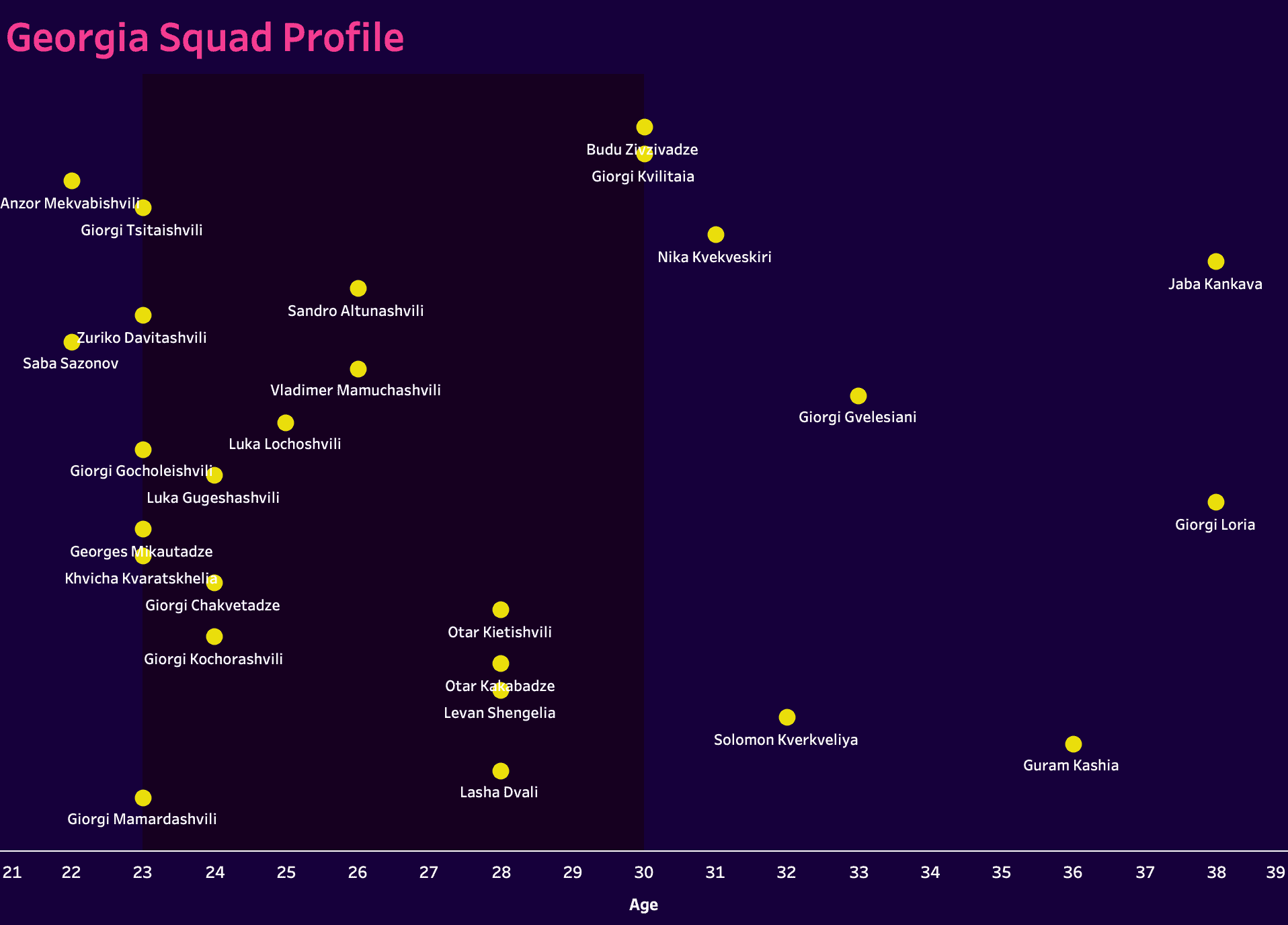
Looking at Georgia’s overall squad profile, it would suggest that Willy Sagnol has heavily leaned on his new young stars to guide the nation towards their first-ever major tournament, an achievement which has seemed a long time coming after missing out on Euro 2020 in a heart-breaking fashion.
With a huge mental battle on their hands as rightful underdogs this summer, Georgia will place faith in their more experienced players to set the tone and subsequently allow their rookies to thrive with limited expectations on their shoulders.
Attacking Phase
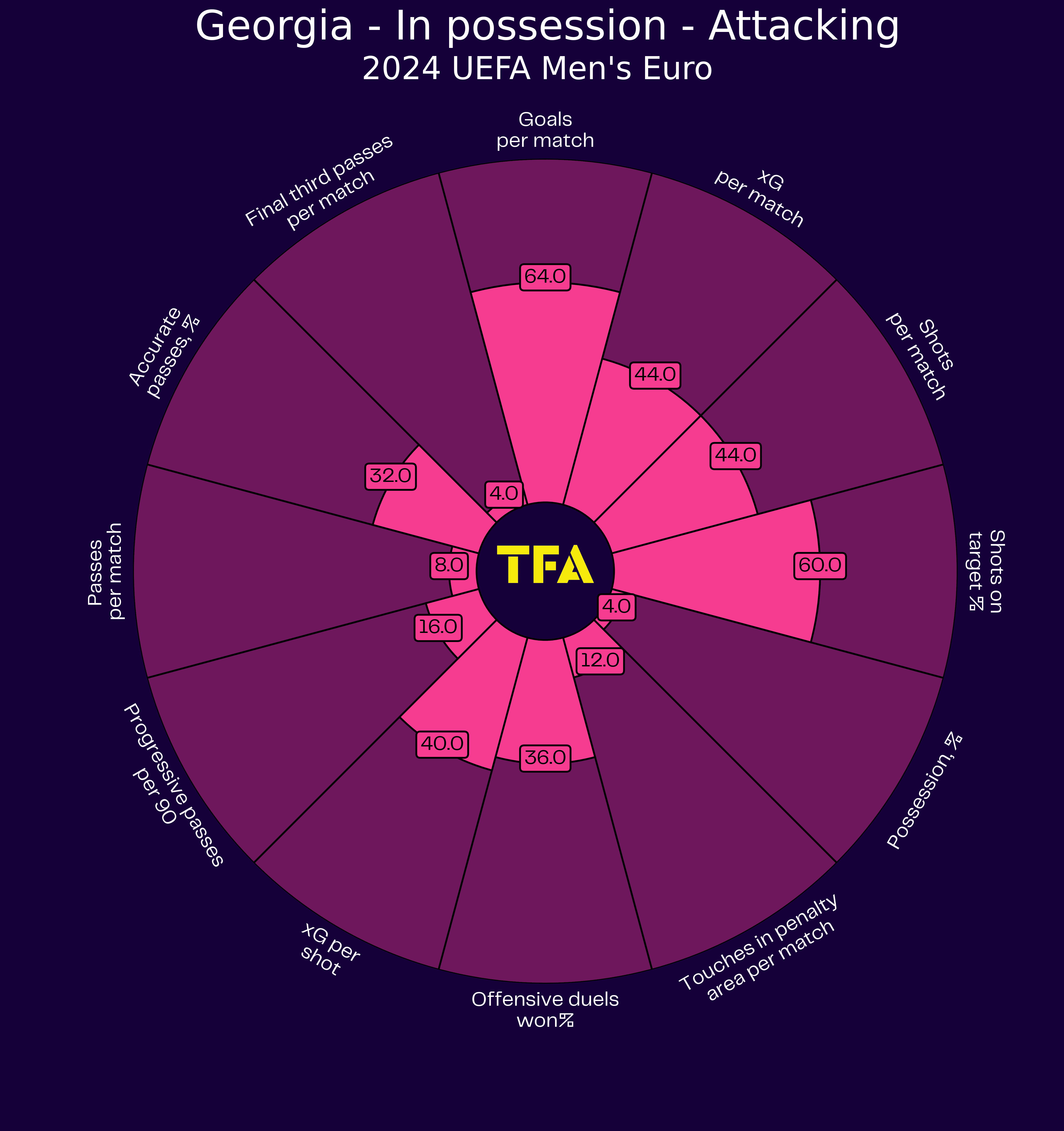
In the initial phase of build-up, Georgia looks to spread their three central defenders across the pitch to create passing outlets for goalkeeper Mamardashvili.
This then allows one of the two central midfielders to drop deeper, creating somewhat of a 3-1-4-2, which aims to pull opposition markers forward and relieve pressure in the middle third.
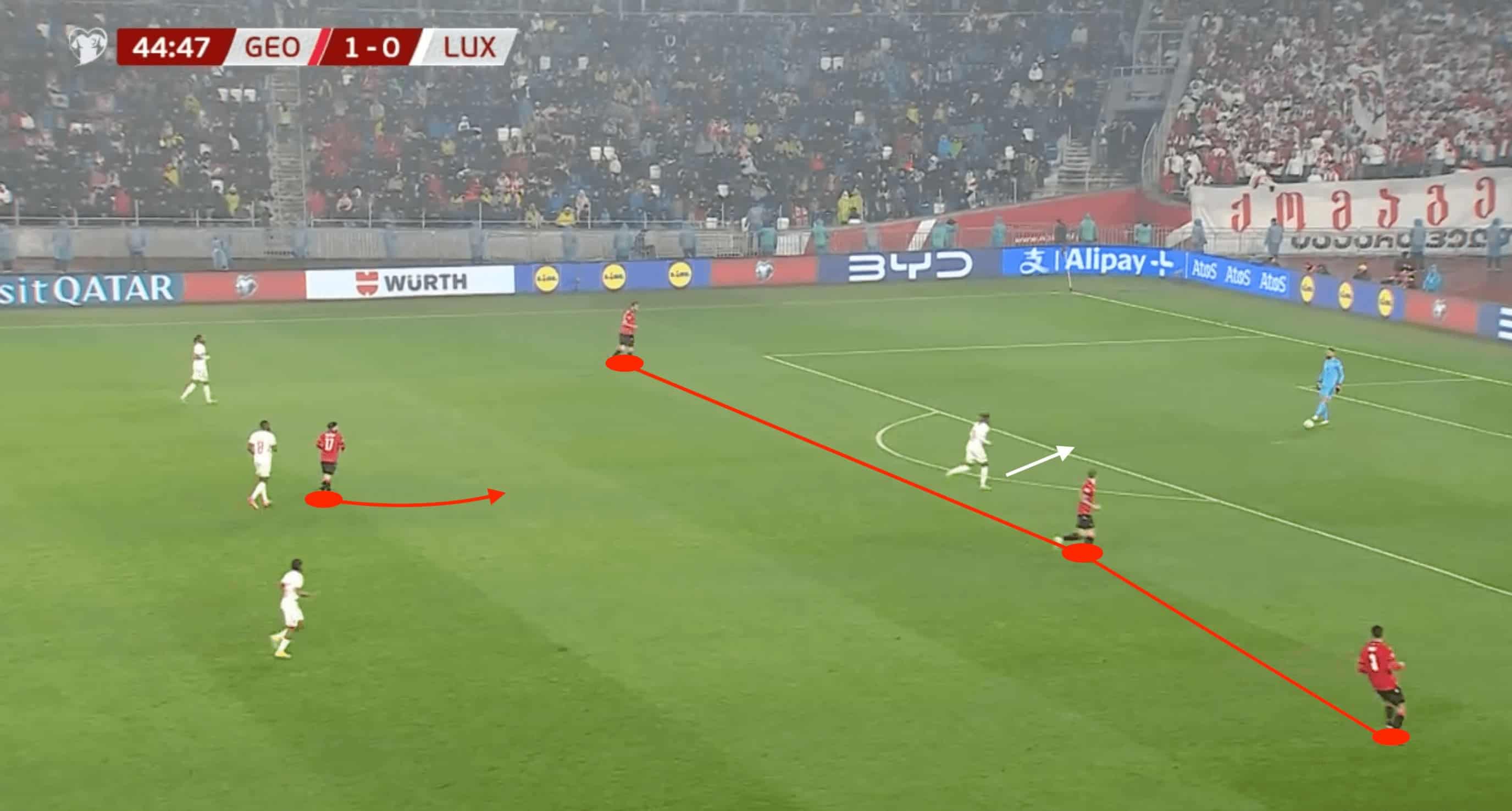
Importantly, against Greece in the Euro Playoff, we saw right-sided central defender Kvirkvelia step up into defensive midfield to add an extra layer to Georgia’s build-up.
Most crucially, this pulled Greek winger Pelkas inside the pitch, freeing up the outlet ball to Kakabadze on the right flank, something integral to their attacking play.
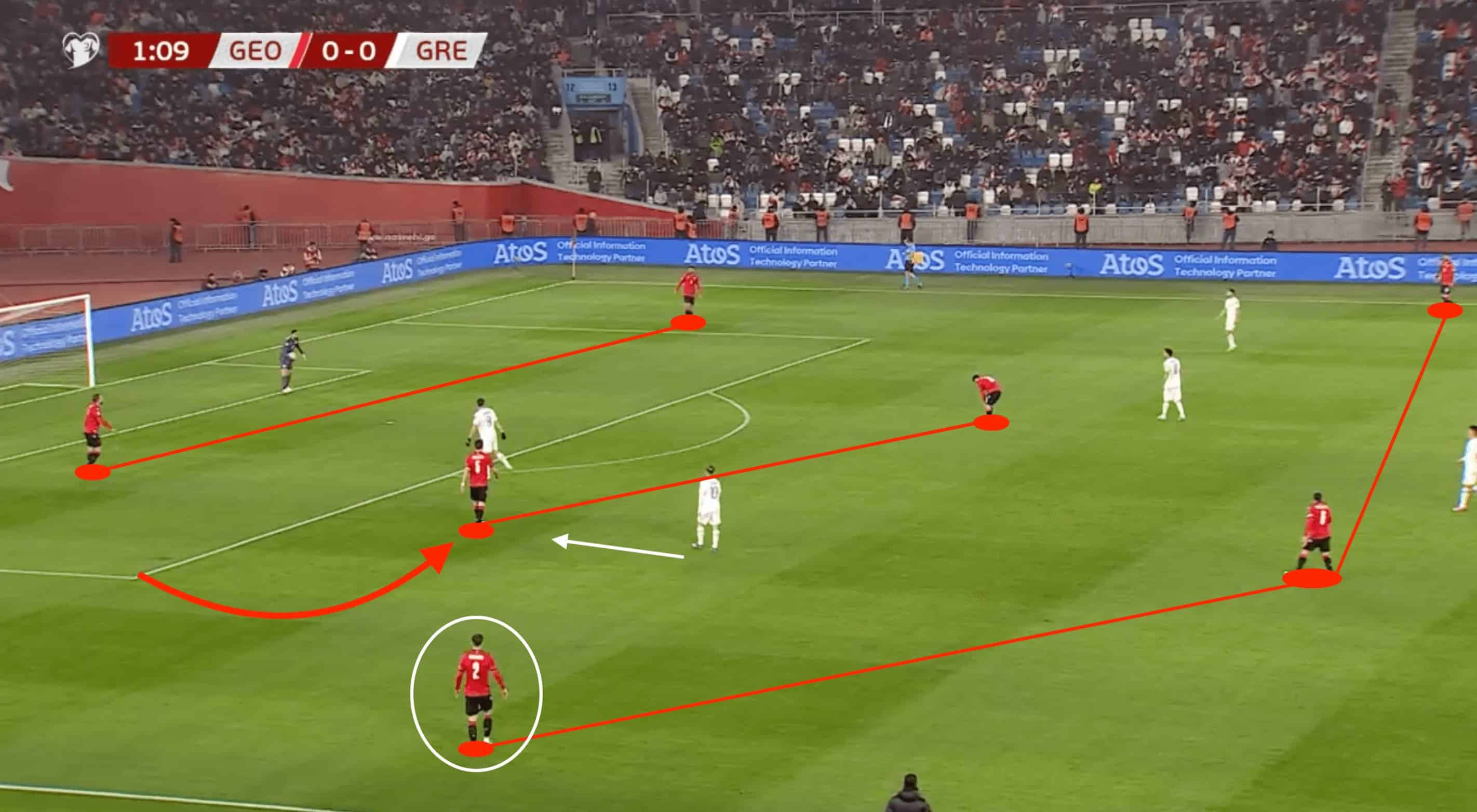
In the 3-5-2, the movement of both Shengelia and Kakabadze will be imperative to Georgia’s success if they are to achieve shock results against the likes of Portugal.
Longer distribution towards the flanks allows Georgia to be combative and aim to win second balls due to their overloads out wide, with Chakvetadze often finding a free role to drift into the channels behind the strike partnership.
When breaking into the final third, the wing backs remain high and wide, offering important creative positions with their crossing prowess- whether it be diagonal balls aimed towards the box for Kvaratskhelia and Mikautadze to play on the shoulder and run onto or crosses swept into the box from the byline.
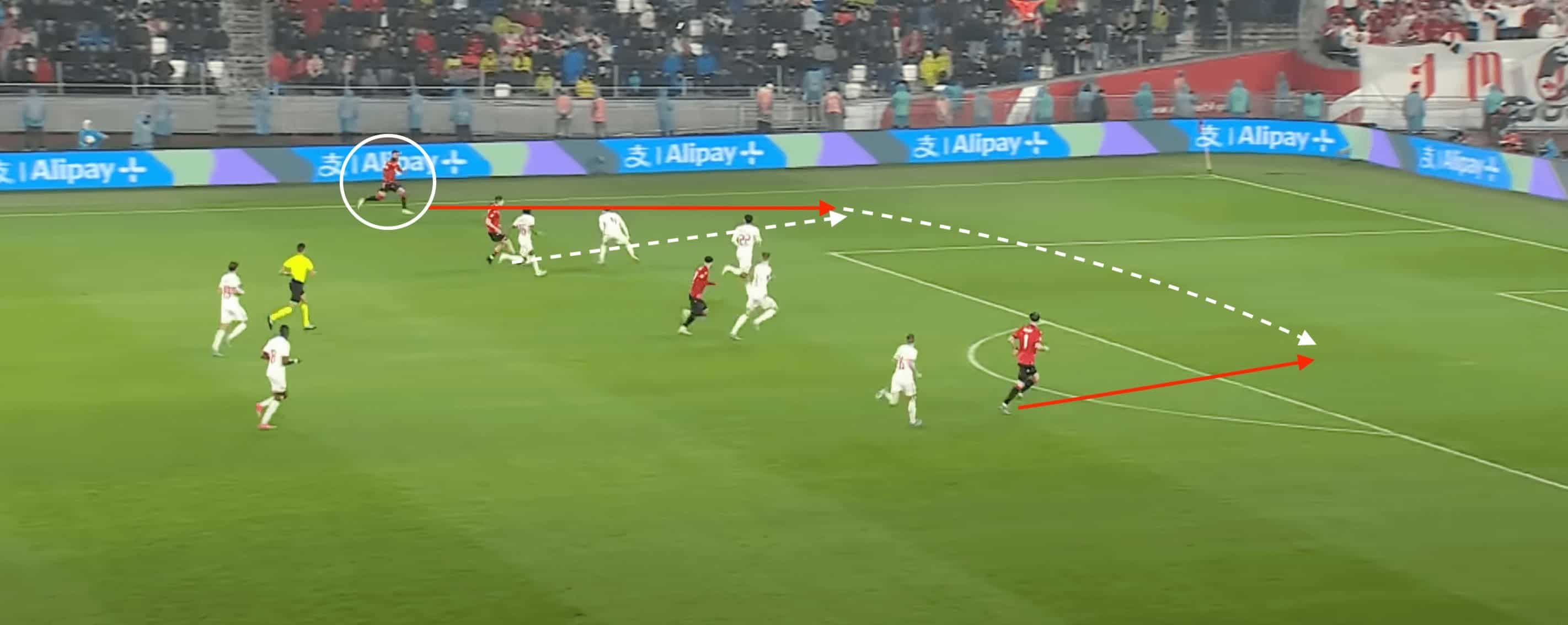
The inventive attacking trio is certainly led by Khvicha Kvaratskhelia, orchestrating the majority of offensive play, dropping deeper in an attempt to collect the ball but additionally acting as an out-and-out number 9 running off the last defender.
The trio’s explosive nature causes fear in opposing defences, with their ability to interchange positionally running defences ragged.
Even though Kvaratskhelia has developed into more of a household name which Georgia looks towards to inject an element of flair, Chakvetadze also impressed throughout qualifying with his confidence and unwavering ability to avoid pressure and distribute to those crucial wider areas.
Defensive phase
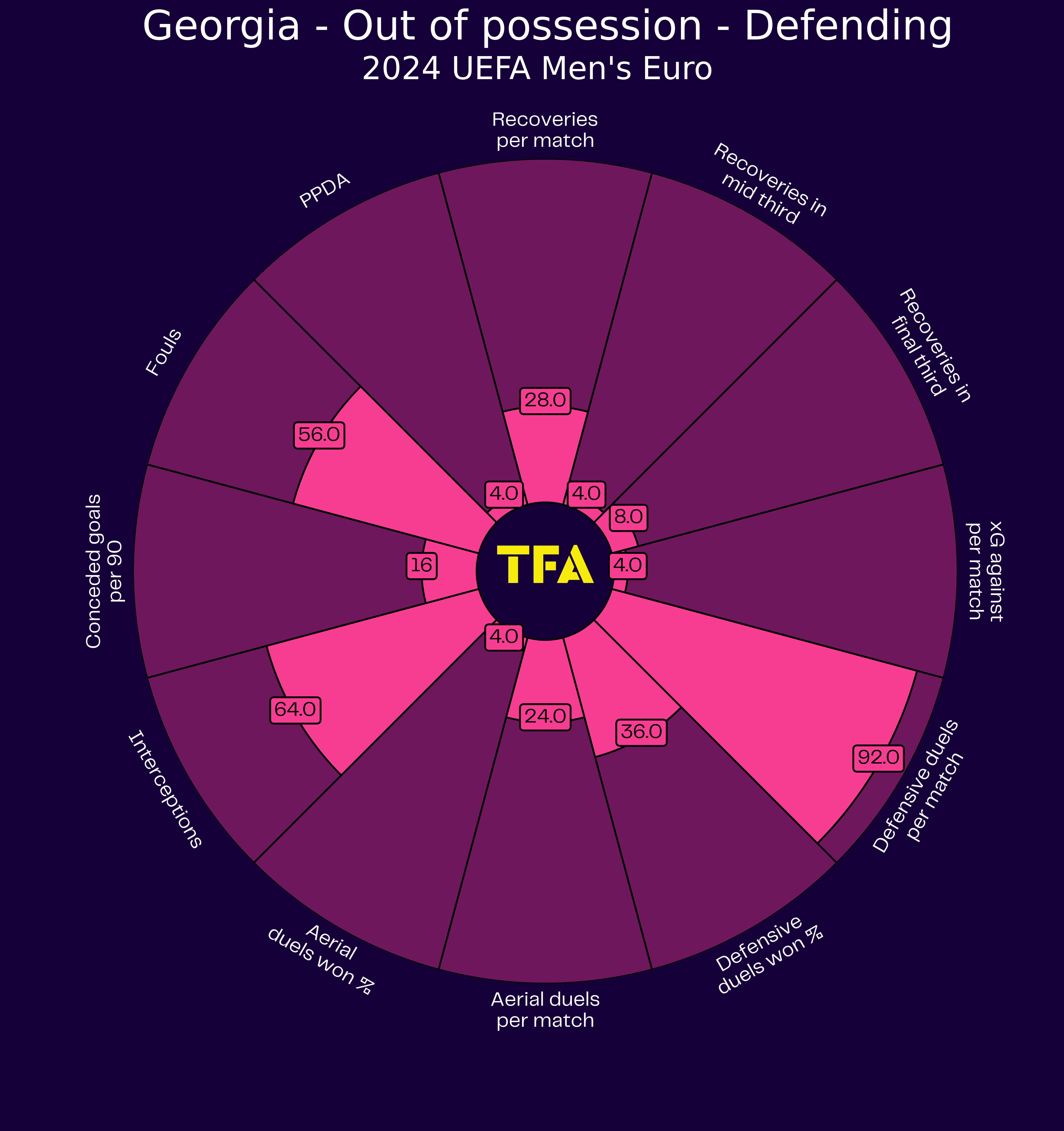
To emerge with any points in their group, Georgia will have to remain resolute in the defensive phase against some of the most free-scoring sides in the tournament.
Whilst their qualifying performances wouldn’t exactly fill Georgian fans with too much hope of not conceding, two clean sheets in the Playoff phase allowed Sagnol to showcase a new-look resilience when it mattered the most.
Naturally, Georgia aims to drop both wing backs into the defensive line, operating in the 5-3-2 when out of possession.
An interesting change would be the fact that Willy Sagnol’s side has shown much more urgency in their pressing efforts when compared to the beginning of their qualifying campaign.
A half-hearted pressing effort against Spain handed them a 7-1 defeat, with Spain’s technically gifted defenders given the freedom to loft passes towards the corners, which allowed the likes of Gavi to find space in the penalty area on the cutbacks- unpicking Georgia’s low block.
On the other hand, Georgia was much more proactive in the recent victory against Greece, aiming to eliminate progression immediately.
Kakabadze pressed high on the right flank to join the forward line in pinning the Greek defenders back.
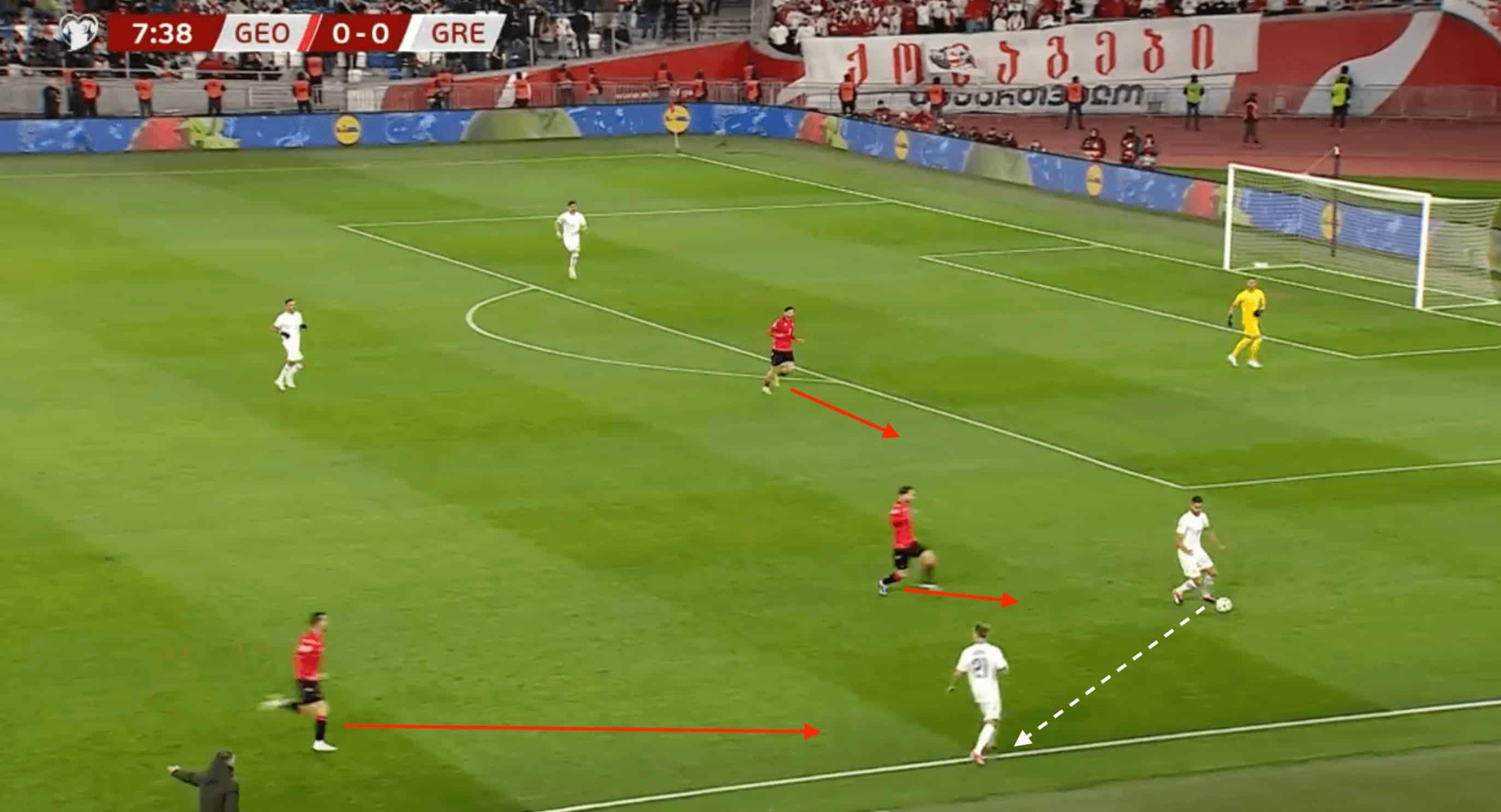
Even though it is potentially risky against stronger opposition, the likes of Kashia have had success stepping up to press the opposition forwards with their backs to the goal.
In a coordinated effort, the Georgian midfielders can then close in and force the ball to be returned to the defence, who recycle play.
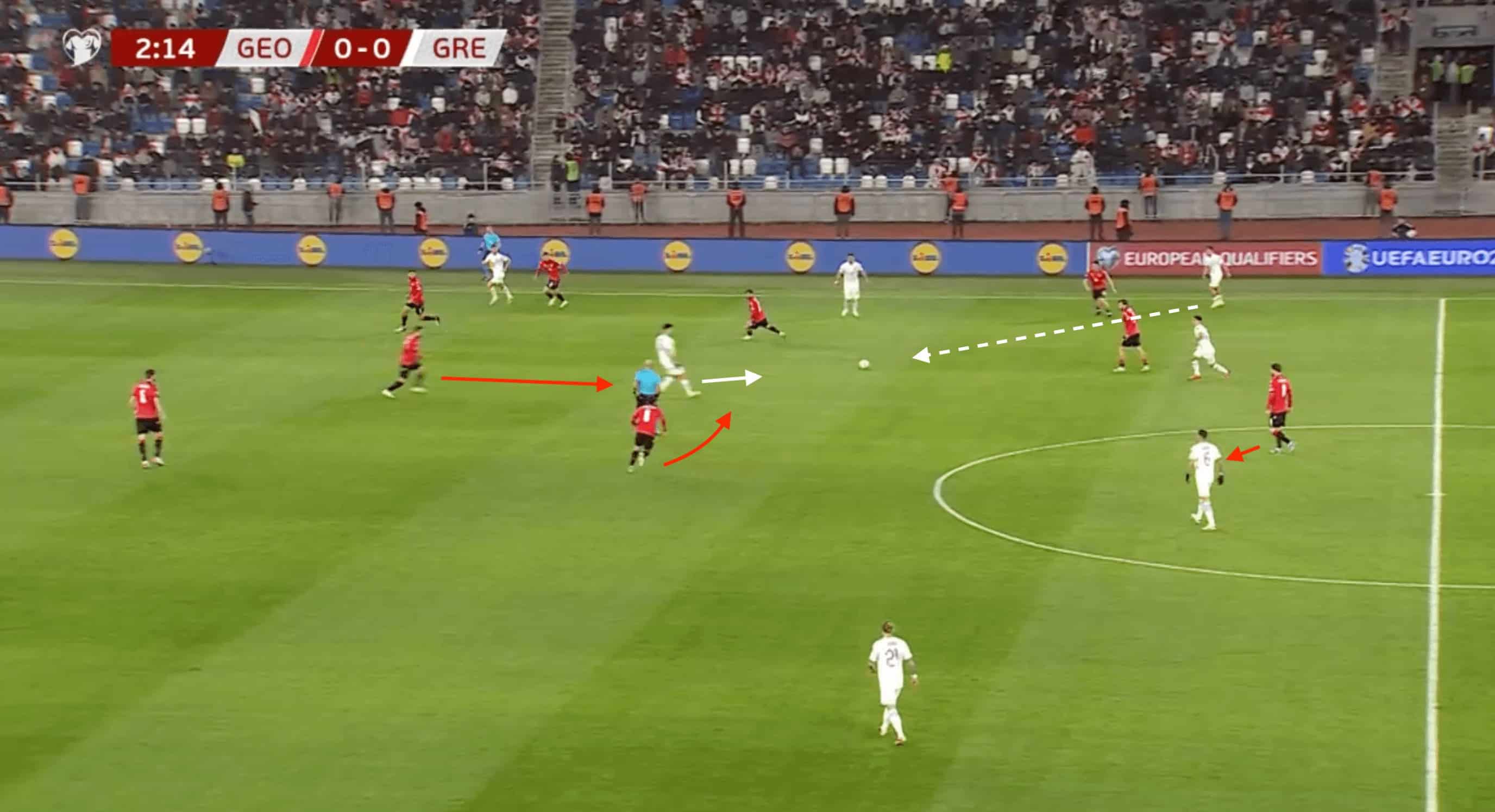
Due to their focus on a collective shape, Sagnol’s men often create defensive overloads to limit progression along the flanks, with wing-backs creeping forward and wide centre-backs covering the vacated space.
These defensive quartets, which form between the attackers and midfielders, create almost an impenetrable blockade through the central areas, often resulting in the ball carrier retreating and looking for a switch of play to attack the space.
However, because this often comes after all pace is sucked out of the initial progression, Georgia can quickly react and assume a similar shape on the opposite flank.
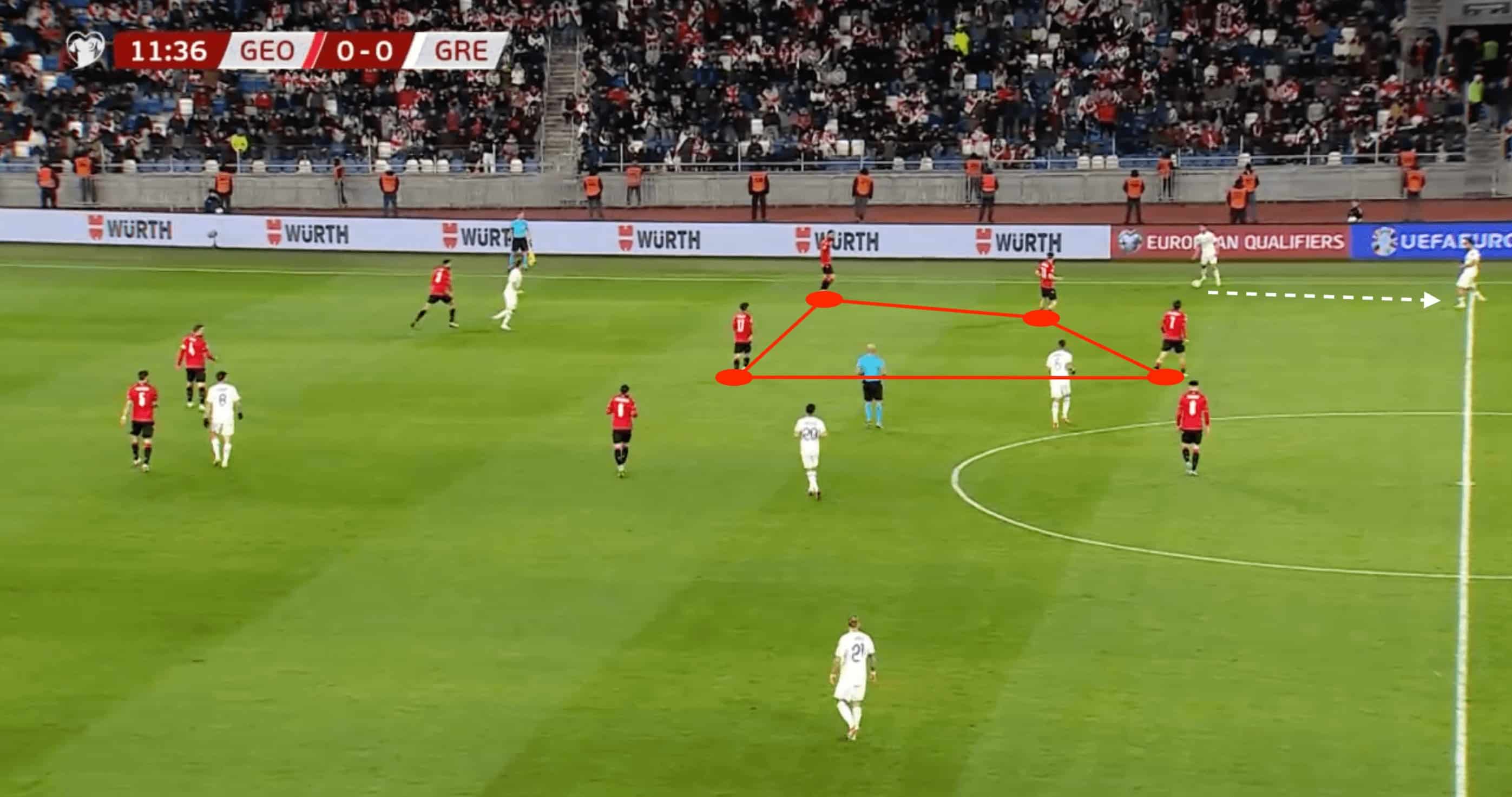
Transitions
When it comes to attacking in transition, Georgia’s initial shape allows them to be successful when springing into life in the event of a turnover.
With Chakvetadze dropping into the midfield 3 when out of possession, he represents a worthy ball carrier and an excellent player when driving forward on the counter with his ability to spread the ball towards the flanks.
The striker partnership of Kvaratskhelia and Mikautadze will look to split wide and threaten through the half-spaces, with Chakvetadze given increased freedom to attack straight down the throats of the opposition.
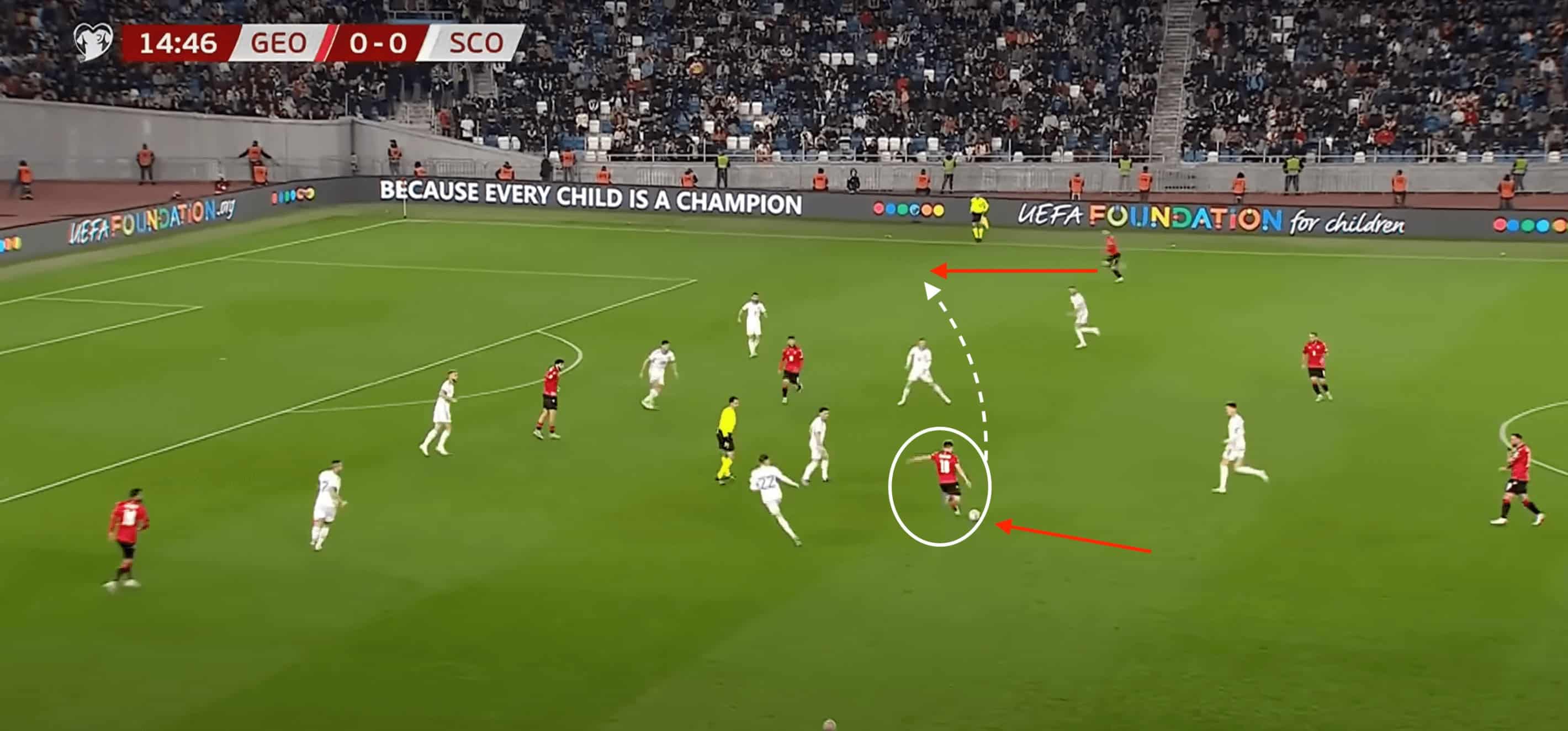
This then gives Georgia the alternative strategy of allowing their star man to invert from the left flank should he receive the pass in space, a position in which he can certainly be devastating with his quick feet and excellent ball striking.
Should they lose possession and have to defend in transition, the quick shift to the 5-3-2 means that they can recover into a strong shape.
We would expect Sagnol’s side to be much more reserved when it comes to pressing high due to the fact that the sides in their group have technical midfielders that can quickly bypass any sort of press if not executed to near perfection.
In turn, this allows Georgia to be less vulnerable in transition because they will have increased numbers back within their own third of the pitch.
Forwards
When it comes to the attacking prowess of Georgia, it would be foolish to overlook the explosiveness and innovation of their star player, Khvicha Kvaratskhelia.
Despite missing their playoff victory against Luxembourg through suspension, he was the man who salvaged what would’ve been an otherwise disappointing showing throughout the qualifying phase.
His 4.78 successful dribbles per 90 and 3.65 shots per 90 are among some of the most influential attacking players throughout the entirety of the competition, with his 8.31 defensive duels won per 90 also underscoring his influence in the defensive phase as well.
We also saw Zivzivadze shouldering attacking responsibility in his absence, with a crucial brace to send Georgia into the Playoff final.
Midfielders
Georgia’s midfielders will have a huge task on their hands when it comes to maintaining possession and making use of the few opportunities which arise for them to progress the ball to the dangerous frontmen.
Therefore, they will have faith in the passing quality of Kochorashvili after the Levante midfielder boasted 5.24 passes into the final third this season in the Segunda División.
Much like his fellow countrymen in defence, Kochorashvili also recorded an impressive 6.84 ball recoveries per 90, highlighting how effective this midfield needs to be on both sides of the ball.
Defenders
Georgia’s overall defensive picture would suggest that they have certainly shown promise, but will their toughest challenge yet be a step too far? As a collective, they ranked in the 92nd percentile for defensive duels per match, but ranking in the 36th percentile for duel success would certainly be alarming.
Having previously mentioned, their ability to transition quickly will be imperative to their success in the final third; Georgia will be encouraged, with Kashia ranking 4th for ball recoveries (68) across the entirety of the qualifying period.
Along with Kvirkvelia ranking in the 70th percentile for accurate long passes with 4.43 per 90, Georgia’s defenders will be important in bypassing fierce pressing sides and working it to their most creative outlets.
Key player
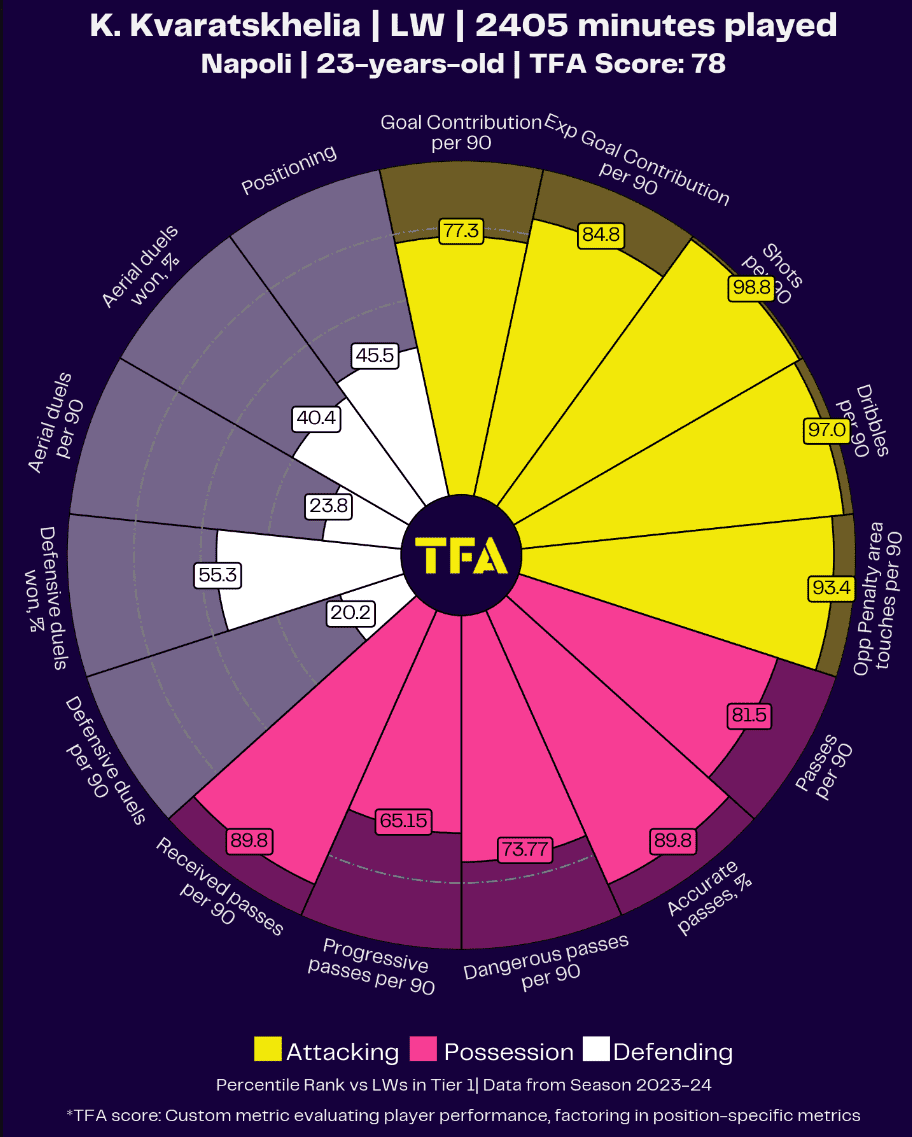
It will probably come as little surprise that we have identified the Napoli superstar as the player that will keep Georgia ticking throughout the European Championships.
Even though he has begun to adopt a much more central starting position in an effort to gain possession much more frequently, he also remains effective drifting in off the left flank, with opposition often seeing him open up and finding the far corner before it is too late.
It will be interesting to see how he fairs as the number 9, with his physical deficiencies possibly suggesting that he may succumb to the defensive dominance of world-class central defenders like Rúben Dias.
He is much more successful when running into space through the centre, with his equalising goal against Spain allowing him to split the two centre-backs before latching onto the ball played in behind by Chakvetadze.
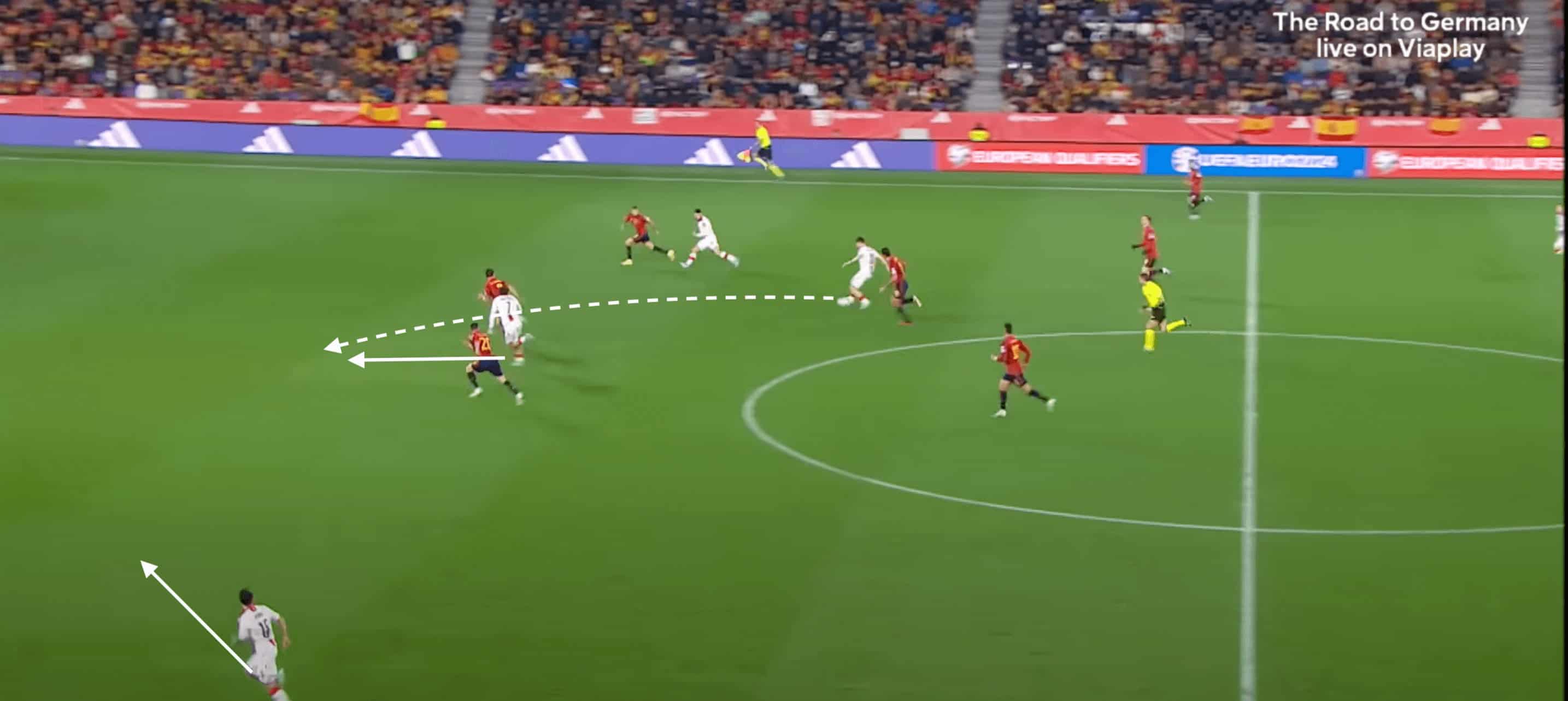
Tournament Prediction
Even though Georgia certainly can achieve a surprise result this summer, we would have to suggest that their first major international tournament will probably falter at the first hurdle- which will still represent a huge improvement and platform to build upon! The more experienced European nations like Portugal and Turkey will look to battle it out for automatic qualification to the knockout stages, with the Czech Republic looking to flex their muscles, having been pipped in the qualifying groups by Albania.
Willy Sagnol has been realistic about his side’s expectations, but this next generation of Georgian footballers definitely won’t leave Germany without exciting supporters and putting up a stern fight.

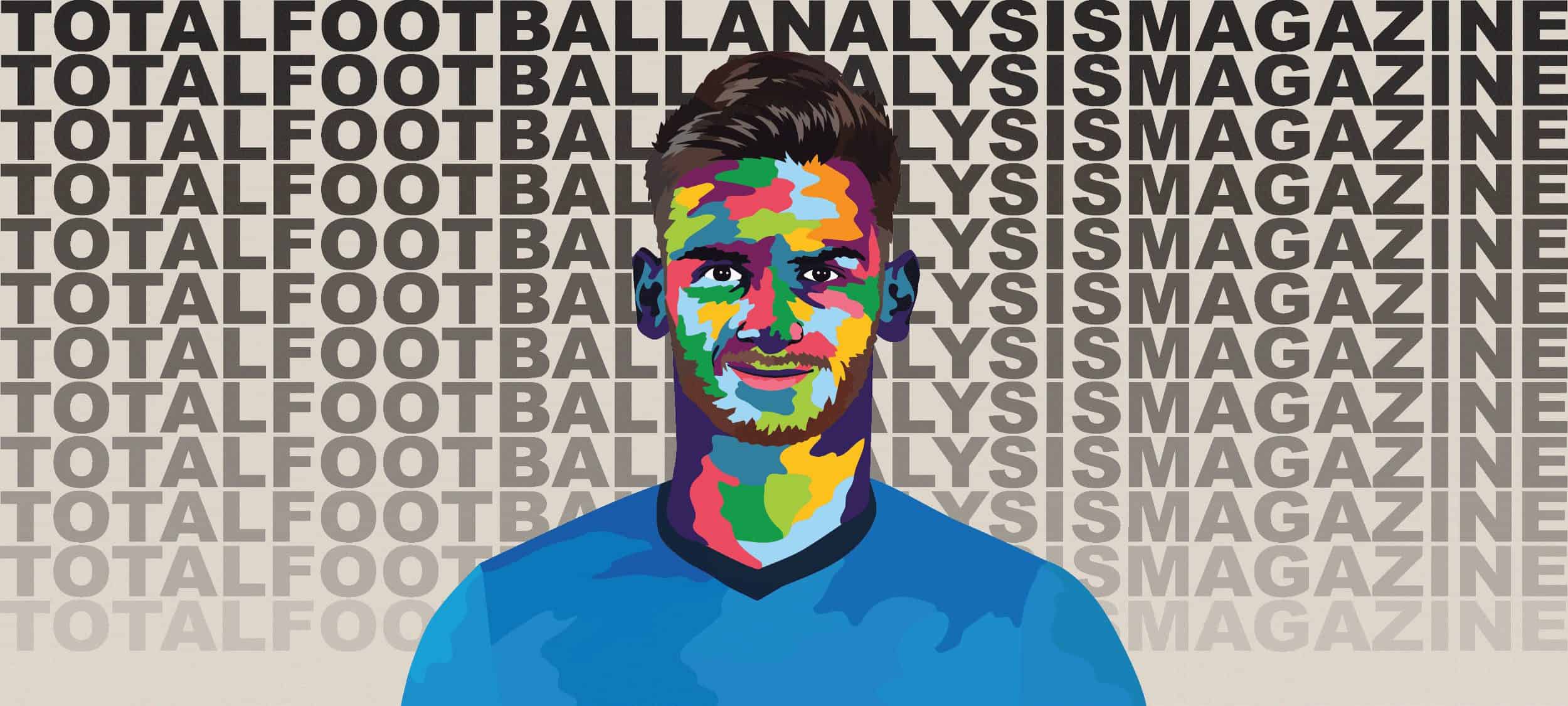



Comments